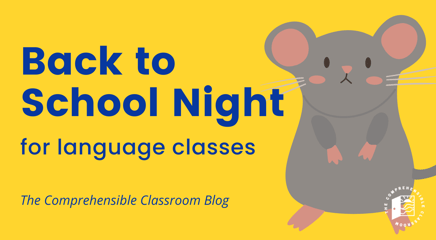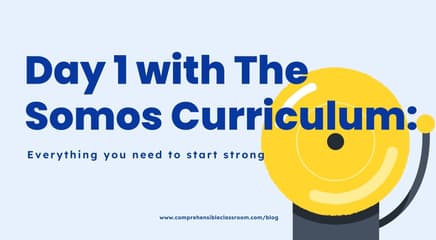Whether you are planning to use the SOMOS 1 or 2 Spanish curriculum for the first time this fall or have been working with it for several years already, I hope that this post will answer most of the 'big' questions that you have as you are planning for the upcoming school year. For everything else, try asking in the SOMOS Curriculum Collaboration group on Facebook to get a timely answer.

FAQ #1: How did you choose Core Vocabulary?
Spanish 1: I chose the novels that I wanted my students to read by the end of Spanish 1B (their second year of Spanish) and made a list of the vocabulary that they would need to read it. I ‘sequenced’ it based on importance and which words grouped well together for storytelling and cultural exploration. I originally backward planned from El Nuevo Houdini.
Spanish 2: I looked at the Spanish 2 textbook that the various high school teachers in my district were using (since mine was the first Spanish 2 course offered at the middle school level in my district) and pulled out the grammar that I needed to ‘cover’ in order to be in alignment with them and get my course approved :) I then chose high frequency words that I could use to provide input for each pattern.
FAQ #2: How many units can I expect to get through in a year?
It totally varies. I saw students for 45-50 minutes per day, five times per week.
In the first year (Spanish 1A), I covered Units 1-20 and then finished out the year with a novel. I have found that almost no one gets this far in the curriculum, especially since I have added lots of optional supplements and extensions for each unit over the last few years since I left the classroom. Any time that I find an #authres, a song, or a topic that connects with a unit, I just can’t resist adding it :) The result is that you have LOTS of different things to choose from for each unit, and you don’t need to do everything. Of course you can if you want ;-) I started out Spanish 1B (the second year of Spanish 1) with Units 21-27, then moved on to a novel, then jumped into my Spanish 2 curriculum. I recommend searching the SCC group archives for this question, since it has been asked MANY times.
My Spanish 2 curriculum filled one full year when combined with two novels.
So, my last full year of teaching, I started my Spanish 1As with SOMOS 1, Unit 1; my Spanish 1Bs with SOMOS 1, Unit 21; and my Spanish 2s with SOMOS 2, Unit 1.
FAQ #3: Are assessments included within the units?
In Spanish 1, most units contain reading, writing, and/or speaking assessments. The assessments are always optional, and the optional assessments included with each unit are listed in this document.
In Spanish 2, few assessments are included. Many teachers that are using the curriculum have created and shared assessments for the units in the SOMOS Curriculum Collaboration group (which I will refer to as the SCC group from here on out).
Midterm and final assessments are not included for either curriculum, but I have shared several options on this blog, and teachers have also created and shared options in the SCC Facebook group.
FAQ #4: Do I have to do everything?
No! If you are feeling overwhelmed by all of the things that are included with each unit and feel like you need to move faster (or want to skip something), don’t worry! As long as you find some way to expose your students to the target structures for each unit (a TPRS story, MovieTalk, reading, discussion, storytelling, etc.), your students should be able to handle the following units. You might find that you get to one unit and your students already know all of the structures from non-SOMOS sources (weekend chats or personal especial, for example). Each unit assumes that students are familiar with the structures from all previous units, so I DO recommend spending some time with each set of structures before moving on to the next unit.
FAQ #5: What else do I need?
For Spanish 1, you don’t NEED anything else, but I would recommend teaching at least one novel and/or implementing a Free Voluntary Reading (FVR) program. You will need reading materials in order to do this. You can purchase novels from Fluency Matters, TPRS Books, Mira Canion, Spanish Cuentos, other independent authors, or many other places. To fill a year of Spanish 2, you will definitely need to purchase some novels or find/create other materials to fill your year.
FAQ #6: Which novels do you recommend I use with SOMOS?
- For the first class novel, I recommend using either Brandon Brown dice la verdad or Brandon Brown quiere un perro as a first read. Even high schoolers love them!
- My preferred second novel is Agentes secretos y el mural de Picasso.
- After that, I would recommend teaching Esperanza. Both are highly cultural and engaging.
- From there, I would check out El Nuevo Houdini or Brandon Brown versus Yucatán.
- The best way to decide is to order one copy of each novel that you think might work and read them for yourself. There are many more, excellent novels than I have listed here; these are just my personal preferences. You will be able to make the best decision for your classes once you are familiar with the content, reading level, and pacing of each novel.
- And…if you want to teach a whole-class novel, I recommend stopping everything else and doing ONLY the novel until you get through it. More on that here.
FAQ #7: Does SOMOS work at the elementary level?
I developed SOMOS while teaching at the middle and high school levels. I do not recommend using SOMOS at the elementary level, at least as it is written. The curriculum is content-rich, and assumed background knowledge and maturity level is 6th grade plus. Because elementary programs typically have extremely limited seat time, I recommend choosing a curriculum that is specifically written for programs with those constraints. Four resources that I strongly recommend checking out for elementary Spanish are ¡Hola niños! (a curriculum from Fluency Matters), Había una vez (a curriculum from Amy (Roe) Vanderdeen of The Storyteller’s Corner), resources from Mrs. Spanish (Anne Marie Mitchell, who uses SOMOS with some of her older kids and so her elementary resources typically work well with SOMOS), and Spanish Cuentos.
FAQ #8: What changes should I make if I teach a block schedule?
It is unrealistic to plan to cover two full days of lesson plans from the curriculum in one 90 minute block. You will need to allow time for movement and ‘rest’. I recommend using lots of brain breaks and taking a look at Sara-Elizabeth’s primacy/recency lesson plan template. Look critically at the activities that I lay out for a week, and consider how you might move them around in order to fit into her lesson plan template given that there are two learning ‘episodes’ happening in each block period.
FAQ #9: Are grammar lessons included in the curriculum?
No. I do not include grammar lessons in the curriculum, nor in the bundles. Because we know that explicit instruction does not supersede the order of acquisition, many teachers do not choose to teach explicit grammar lessons and so I would hate to price units for their inclusion when many teachers would not use them. If you are a teacher like me that has chosen to give short grammar lessons following rich, extensive input, you can purchase my grammar lessons separately. Choose when to teach them based on how familiar your students are with the topic (ex: give an -AR present tense conjugation lesson once students have seen lots and lots of different -AR verb endings across several units and you have done pop-up grammar throughout). This will be different for each teacher, and here is a link to the grammar category in my store.
FAQ #10: How can I get by without printing so many activities?
Whether you are desk-less, 1:1, or just don’t want to use a lot of paper, there are several ways to work around printing the many activities that I include in the curriculum. I suggest creating class sets of materials whenever possible. Laminate anything that will be manipulated. You are also allowed to give students access to digital versions of files IF those files are in a password protected area (such as google classroom where each student has a unique password). Replace writing activities with class discussion or have students use individual whiteboards instead.
You can now assign any reading from the curriculum through Garbanzo!
FAQ #11: Can I skip the TPRS story portion of each unit since I am not good at it?
Please see this post about what to do if TPRS is failing. You can also read this post about managing responses and this post about soliciting illustrated responses. Another good post is this one by Annabelle Allen about Story Cubes.
Please also watch this video on NOT Storyasking from Summer 2019:
FAQ #12: What homework should I assign with SOMOS?
I do not assign homework, nor do I recommend assigning homework. If you have to or want to, check out Sara-Elizabeth’s real world homework ideas. Many units include a ‘bonus’ worksheet (storyboard, reading, puzzle, etc) that you could assign as homework, and a group of SOMOS teachers has even collaborated to create at least two such activities for each unit that teachers can use as absent work or homework. It is all in the Drive folder of the SCC Facebook group!
FAQ #13: I need to follow a textbook curriculum and administer textbook exams. Is SOMOS compatible?
If you are tied to a textbook, you will need to do a good bit of manipulating. You will either need to follow the SOMOS curriculum and supplement with explicit vocab and grammar lessons before each textbook assessment, or you will need to follow the textbook and inject lessons and activities from SOMOS where they match the textbook content. It’s definitely not ideal, although there are teachers out there making it work.
FAQ #14: How can I use SOMOS with interactive notebooks?
Check out the Interactive-ish notebooks video in our SOMOS Collaboration Group!
FAQ #15: Is SOMOS compatible with AP or IB?
Teachers that are familiar with these programs and tests say “yes”, although I do not have personal experience with either. Ask in the SCC group for specific feedback from teachers in the know ;-)
FAQ #16: Is SOMOS available in other languages?
The first nine units are available in French, and more are in the works. There are no plans for it to be available in other languages.
FAQ #17: Do you plan to release curriculum for Spanish 3 or 4?
No. I recommend teaching a novel-based curriculum for upper levels. Search the SCC group archives for specific suggestions from teachers with experience (I never taught upper levels with comprehension based methods, so my suggestions are all just theoretical, not based on personal experience). Kristy Placido, Carrie Toth, and Kara Jacobs all have blogs and TpT stores with lots of great resources for these levels, and Allison Wienhold and Cynthia Hitz have blogged extensively about using novels and other resources in their upper level classes.




